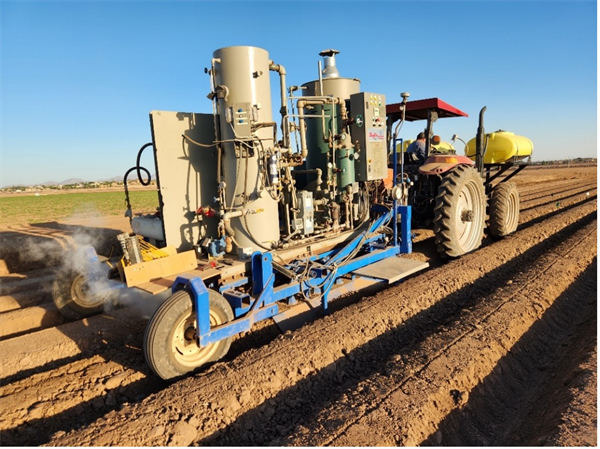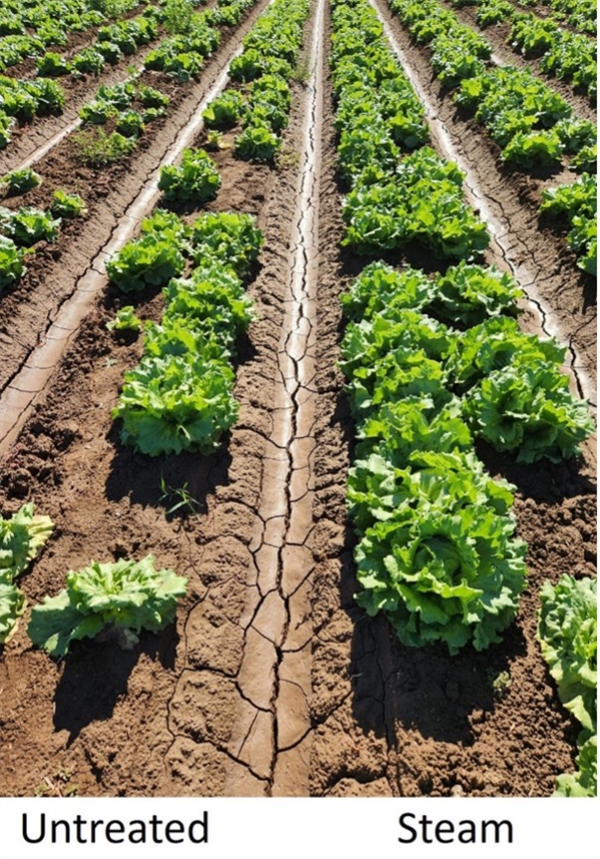
I am seeking samples of downy mildew on lettuce from around Yuma County to support the Michelmore Lab and their ongoing efforts to help characterize the downy mildew populations of the United States. The Michelmore Lab has led the charge on a survey of Bremia variants since 1980 and has been instrumental in demystifying the gene-for-gene nature of lettuce resistance to downy mildew.
Their group invites growers across the United States to submit downy mildew infected plant samples, which are then used to culture the Bremia on live host plants. The team then inoculates a panel of lettuce varieties carrying known resistance genes to determine the race of each isolate they receive. Identifying which races occur in which specific fields is essential to guiding the breeding of new resistant cultivars and maximizing the effectiveness of host-based genetic disease management. The data obtained from these tests are also used to designate new Bremia races through the International Bremia Evaluation Board.
Your contribution will help breed better lettuce for Yuma. This means less breakdown of resistance in the field, and better yields for Yuma growers. To facilitate these submissions the Yuma Plant Health Clinic will be setting up a separate drop-off point and submission sheet for downy mildew sample submissions in the same hallway we use for standard plant diagnostic submissions. The drop-off point will be clearly labelled and consist of a chest-style refrigerator and printed copies of the submission form. It is vital to keep these samples cool so they remain viable for future inoculations, so please place your samples inside of the refrigerator before you leave.
Shipping will be handled by the clinic. All we ask is that you fill out the submission form as completely as you can. An example of the questions that are asked in that form so you can prepare ahead of time can be found HERE .In a prior article (Vol. 14, Issue 19), I discussed the initiation of a fall 2023 trial examining the use of band steam for controlling Fusarium wilt of lettuce. Again, the premise behind the research is to use steam heat to raise soil temperatures to levels sufficient to kill soilborne pathogens. For Fusarium oxysporum f. sp. lactucae (FOL) the pathogen which causes Fusarium wilt of lettuce, the required temperature for control is generally taken to be > 140°F for 20 minutes. Soil solarization, where clear plastic is placed over the crop bed during the summer, exploits this concept. The technique raises soil surface temperatures to 150-155˚F, effectively killing the pathogen and reducing FOL disease incidence by 45-98% (Matheron and Porchas, 2010).
In our trials, we used steam heat to raise soil temperatures. Steam was delivered by a 35 BHP steam generator mounted on a custom designed elongated bed shaper (Fig. 1). As the device traveled through the field, steam was injected into the soil in narrow bands centered on the seedline. Four band sizes ranging from 4” wide x 2” deep to 6” wide by 4” deep were examined to determine the optimal width and depth of the band of soil that needs to be disinfested to prevent disease. Travel speed was 0.2 mph and soil temperatures were raised to about 190°F. After cooling (< ½ a day), the crop (FOL susceptible iceberg lettuce variety El Guapo) was planted into the disinfested soil.
Preliminary results are very encouraging (Table 1, Fig. 2). The percentage of diseased plants was roughly four times lower in steam treated plots as compared to the untreated plots at the first evaluation date, 39 days after planting (DAP) (19% vs ~ 5%), and about two times lower at the second evaluation date, 60 DAP (32% vs ~17%). These results are consistent with our previous studies which showed that in soils that have moderate FOL inoculum levels, steam treatment reduced disease incidence at maturity by more than 40%. A surprising result was that the width and depth of soil steam treatment did not have a significant effect on disease incidence. A logical explanation for this result could not be formulated as one would expect disease incidence to be reduced if a larger volume of soil is disinfested.
Stay tuned for final trial results!
On a slightly different note, if you are interested in seeing the plots, I will be at the field site Field Day this Wednesday, November 30th from 8:00 am-12:00 pm. The location is the JV Farms Fusarium Trial site, located off of Hwy 95 and Ave 5E (32.6920898, -114.5395051).
Hope to see you there!
References
Matheron, M. E., & Porchas, M. 2010. Evaluation of soil solarization and flooding as management tools for Fusarium wilt of lettuce. Plant Dis. 94:1323-1328.
Acknowledgements
This project is sponsored by USDA-NIFA, the Arizona Specialty Crop Block Grant Program and the Arizona Iceberg Lettuce Research Council. We greatly appreciate their support.
A special thank you is extended to Fatima Corona, Pablo Delgado, Chad VanMatre, Matt McGuire and JV Farms for their generous assistance and allowing us to conduct this research on their farm.
|
Table 1. Effect of band-steam on Fusarium wilt of lettuce disease incidence in a trial conducted with iceberg lettuce in Yuma, AZ in 2023. |
||
|
|
----------------- Disease Incidence, % ----------------- |
|
|
Treatment1 |
39 DAP2 |
60 DAP |
|
Band-steam: 4”x2” |
2.4 |
17.5 |
|
Band-steam: 4”x4” |
5.0 |
15.0 |
|
Band-steam: 6”x2” |
8.5 |
22.4 |
|
Band-steam: 6”x4” |
3.8 |
16.4 |
|
Untreated |
19.2 |
32.1 |
|
1Dimensions for band-steam treatments indicate the width and depth of the band of soil that was treated with steam. |
||

Fig. 1. Band-steam applicator principally comprising a 35 BHP steam generator
mounted on a bed-shaper applicator sled. The device injects steam into the soil
as beds are formed.

Fig. 2. Fusarium wilt of lettuce control with band-steam in iceberg
lettuce. Steam was applied in a narrow band (4” wide x 4” deep)
centered on the seedline prior to planting. After the soil cooled (< 1/2
day), the crop was planted into the disinfested soil.
In the absence of Dacthal (DCPA) growers are looking for different herbicide options for Broccoli and Onions.
The following is data from a broccoli trial done in 2010 by Tickes/Pena, which compares Prowl, Goal Tender, Prefar, Treflan, Devrinol and Dacthal at different application timings. Plots were visually evaluated for weed control of Goosefoot (Chenopodium murale), Malva (Malva parviflora), and Yellow Sweet Clover (Melilotus oficinalis). The label recommendations for Devrinol are “Use the lower rate on light soil (coarse textured-sandy), and the higher rate on heavy soil (fine textured-clay)”. The rate goes from 1-2 lbs on the DF-XT 50% formulation.
We hope this information is useful in our decision making for broccoli herbicide programs.